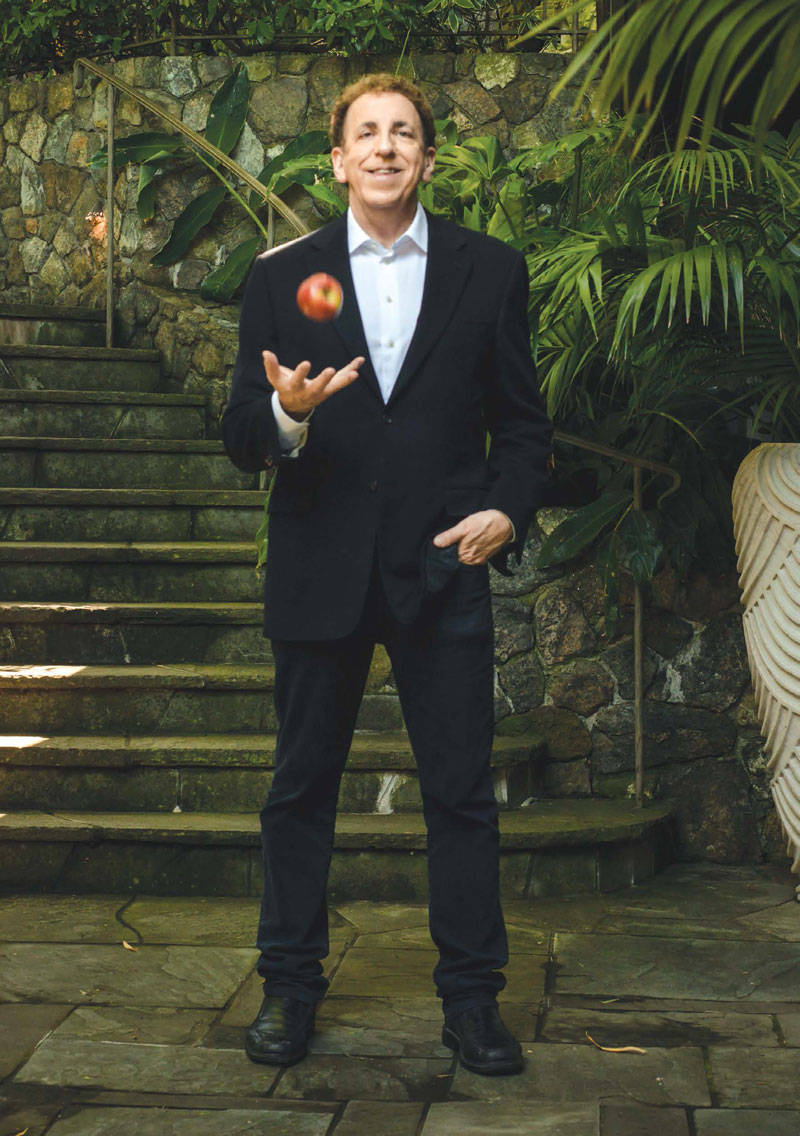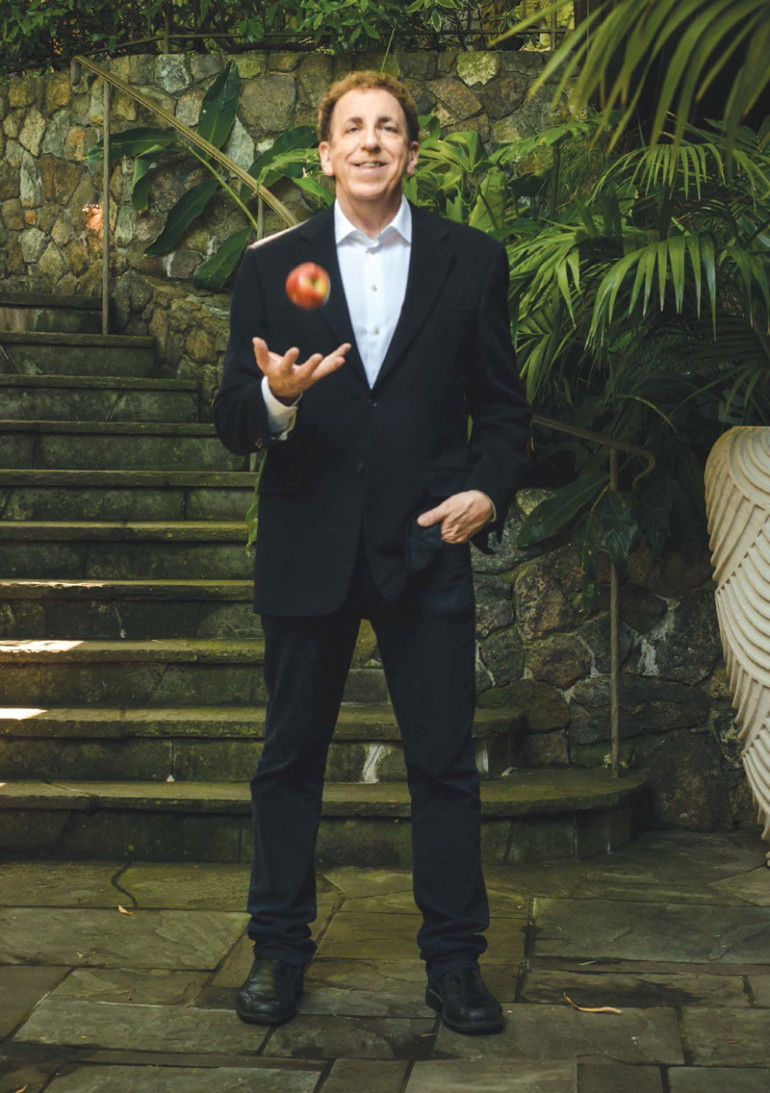
IN A COUNTY of just over 260,000 impressive people, Sausalito’s Dean Ornish, M.D., just might be a little more impressive than most. Singled out by Life magazine as one of the 50 most influential members of his generation and by Forbes as one of the world’s seven most powerful teachers, Ornish, a native of Dallas, Texas has been a personal physician to former President Bill Clinton since 1993 and is still going strong at 64. As the remodeling project for his Preventive Medicine Research Institute on Bridgeway is nearing completion, he and wife Anne are about to publish their book UnDo It!; it comes out next January. Ornish made health history in 1983 when he introduced a then-revolutionary nutrition based regimen for reversing cardiovascular disease without medicine or surgery.
What is the philosophy behind your program and how does it work?
Our bodies often have a remarkable capacity to begin healing if we address the underlying causes of chronic diseases — which are often the diet and lifestyle choices we make each day. This program can be done in combination with drugs and surgery, or sometimes as an alternative to these. My colleagues and I continue to be amazed and inspired that the more diseases we study, and the more underlying biological mechanisms we research, the more new reasons and cutting-edge scientific evidence we have to explain why these simple lifestyle changes are so powerful, how transformative and farranging their effects can be, and how quickly people can show significant and measurable improvements — often in just a few weeks or even less.
What are the benefits of a whole-food, plantbased diet?
A typical American diet is high in animal protein, fat and sugar, which increases production of interleukins, blood chemicals that promote chronic inflammation. In contrast, plant-based proteins contain protective substances such as phytochemicals, bioflavonoids, retinols, isoflavones and many thousands of other substances that actively decrease rather than increase chronic inflammation — providing a double benefit.
Do you take any supplements? Is this part of your program?
There is some value in taking a multivitamin (without iron), particularly if you don’t have the healthiest diet. I personally take and recommend omega-3 essential fatty acids that can be flax, fish or plankton based (with mercury, dioxin and PCBs removed). I also recommend one gram of vitamin C daily and, for most people, vitamin D3. And since recent studies show that turmeric and curcumin have anti-inflammatory properties and can possibly help stave off Alzheimer’s, those should be considered.
What do you think of the plethora of diets and nutrition trends that claim to improve wellness?
Perhaps no field has as much controversy as nutrition — after all, everybody has to eat, and just about everyone has an opinion about it. I’m a veteran of so many nutritional debates and diet wars, but I’m done now. The evidence is now clear. My colleagues and I have shown in 40 years of randomized controlled trials and demonstration projects published in the leading peer-reviewed medical journals that this lifestyle medicine program really works for most people. Others propose various theories about what they believe will work; we’ve proven what actually does. Our research shows that 94 percent of people who enroll in our nine-week lifestyle medicine program complete all 72 hours of training, 85 to 90 percent are still following it one year later. This is an unprecedented level of lasting behavioral change.
Your program is now being offered to patients nationwide; is it expensive?
Medicare and most major insurance companies are now covering our program for reversing heart disease in hospitals, clinics and physician group practices nationwide. They will pay for 72 hours of training. Here in Marin, Dr. Mark Wexman and his colleagues at the Cardiovascular Center of Marin are offering it. The elements of the program are inexpensive. This is really a “Third World diet” along with walking, meditating and loving — all of which cost nothing. When I created this program, I wanted it to be accessible and affordable to everyone. I didn’t want this to be concierge medicine. We created a clinic at St. Vincent de Paul, a homeless shelter in San Francisco, where 30,000 homeless people went through this program at no cost to them.
Are you currently working toward any new discoveries?
Yes, I am grateful to be currently directing the first randomized controlled trial to determine if these comprehensive lifestyle changes may reverse the progression of early stage Alzheimer’s disease in collaboration with doctors Bruce Miller and Joel Kramer at the UCSF Memory and Aging Center.
Who are your influences?
Besides my parents, I would say my life turned around in January of 1973 when my parents were hosting a cocktail party in Dallas for Sri Swami Satchidananda, the ecumenical meditation and yoga teacher. At the time I was dealing with a serious bout of depression and when he said, “It’s true that nothing can bring you lasting happiness — but the good news is that you have it already,” I realized my earlier suicidal depression was manageable. Instead of asking, “How can I get what I need to be happy?” I began asking, “What am I doing that’s disturbing my own inner peace and joy that are already there?”
I understand that you are currently writing a book with your wife, Anne?
Yes, Anne directs program development at Preventive Medicine Research Institute; we’ve worked together and continued to develop our lifestyle medicine program for more than 20 years. My favorite key on the computer is the undo button. I’ve often thought, “Wouldn’t it be nice if there were an undo button for our health as well?” Well, now there is. So the title is UnDo It! It also was inspired by something Swami Satchidananda used to say when people would ask, “Are you a Hindu?” and he’d reply, “No, I’m an Undo.” Albert Einstein once wrote, “If you can’t explain it simply, you don’t understand it well enough,” so Anne and I are simplifying our program down to its essence.
Why Marin?
When I first moved to the Bay Area in 1984, I rented a flat on Divisadero Street in the city. My uncle lived in Sausalito; when I visited him one day, I saw an open house sign and went in. I had an overwhelming feeling that I was home, that this was where I was supposed to live. I’d never experienced anything like this. I didn’t have any money at the time (paying off medical school loans), but I did have a $1,000 line of credit on my new Visa card, which I put down, giving me a week to raise the down payment. I flew to New York City, wrote a book proposal on the plane, and learned that Esther Newberg at ICM was the best literary agent. I didn’t have an appointment and she didn’t know me, so I sat outside her office for two days hoping she’d see me. At the end of the second day, she invited me in and agreed to represent me for the book that ended up being Dr. Dean Ornish’s Program for Reversing Heart Disease. She was able to negotiate an advance sufficient to make a down payment on my dream house — and I’ve lived there ever since (and she still represents me). I love living in Sausalito, my favorite place on earth.
Favorite vegetarian restaurant in Marin?
Surprisingly, there are very few vegetarian or vegan restaurants in southern Marin other than the Veggie Grill in Corte Madera. I’ve learned to frequent a few places where they have vegetarian options available like Poggio, Avatar and Sushi Ran in Sausalito and Farm House Local in Larkspur. It’s a short drive to Greens in San Francisco, my favorite vegetarian restaurant.
How do you get kids to appreciate a healthy diet?
Kids develop their taste preferences for foods when they’re young. They also tend to copy what their parents eat. So, in our home, we serve mostly healthful foods. Nobody wants to feel controlled, even children. When our kids, Lucas and Jasmine, were very young, I said to them, “No one can tell you what to eat, even me. You don’t ever have to eat anything you don’t want.” I’d explain the many benefits of why we serve what we do — to them and to the planet — and they understood and enjoyed eating a mostly whole-food, plantbased diet. We also involve them in preparing food, so they feel a sense of ownership. However, when Lucas became a teenager, he became a carnivore, announcing, “Hey, Dad, I have to rebel — I’ll go back to being a vegetarian when I’m in college.”
Has there been controversy about your claims?
When my colleagues and I first began publishing our research studies 40 years ago showing, for the first time, that heart disease was reversible, there was a lot of controversy since we were challenging the conventional wisdom. Since then, we’ve continued to show that these comprehensive lifestyle changes can reverse the progression of many chronic diseases, including early-stage prostate cancer, type 2 diabetes, high blood pressure, high cholesterol levels, obesity, depression, and others. We also found that changing lifestyle changes genes — turning on genes that keep us healthy, turning off genes that cause many chronic diseases. And we found that these lifestyle changes lengthen telomeres, the ends of our chromosomes that regulate aging — reversing aging at a cellular level. Since we’ve published all of our research in the leading peer-reviewed medical journals, and now that Medicare and most insurance companies have been covering my program for reversing heart disease, these ideas that were once controversial have become mainstream.
Why is Marin one of the healthiest places to live in the state?
Clean air, clean water, overall affluence, a strong community and an ethos of respecting nature all contribute to a healthy, beautiful environment in Marin.
For more information, visit ornish.com.


